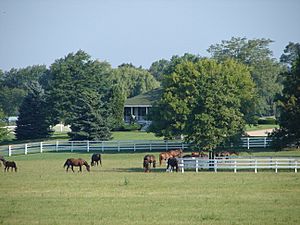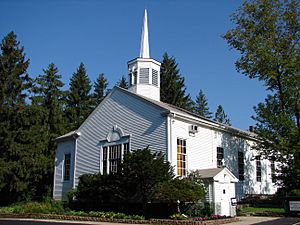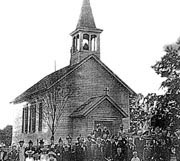Barrington Hills, Illinois facts for kids
Quick facts for kids
Barrington Hills, Illinois
|
|
|---|---|

Horse farm in Barrington Hills
|
|

Location of Barrington Hills in Cook County, Illinois.
|
|
| Country | United States |
| State | Illinois |
| Counties | Cook, Kane, Lake, McHenry |
| Townships | Barrington, Dundee, Cuba, Algonquin |
| Incorporated | July 5, 1957 |
| Government | |
| • Type | Mayor–council |
| Area | |
| • Total | 27.62 sq mi (71.54 km2) |
| • Land | 27.00 sq mi (69.94 km2) |
| • Water | 0.62 sq mi (1.60 km2) |
| Elevation | 774 ft (236 m) |
| Population
(2020)
|
|
| • Total | 4,114 |
| • Density | 152.34/sq mi (58.82/km2) |
| Time zone | UTC-6 (CST) |
| • Summer (DST) | UTC-5 (CDT) |
| ZIP codes |
60010, 60021, 60102
|
| Area codes | 847, 224 |
| FIPS code | 17-03883 |
| Wikimedia Commons | Barrington Hills, Illinois |
Barrington Hills is a village located about 40 miles (64 km) northwest of Chicago in the U.S. state of Illinois. Per the 2020 census, the population was 4,114. It straddles approximately 29 square miles (75 km2) over four counties, Cook, Kane, Lake, and McHenry. The Village of Barrington Hills was incorporated in 1957.
The suburban village is included in the greater Barrington area. Many very affluent residents live on large estates and commute to downtown Chicago. A minimum 5-acre (2.0 ha) zoning restriction has been in effect on new construction since 1963, but the existence of equestrian farms antedates the village by decades. Farming and horse raising are allowed. Barrington Hills includes farms and estates such as Hill 'N Dale Farms, which was owned by Richard L. Duchossois, former owner of the Arlington Park racetrack. It was acquired by Citizens for Conservation in 2022 CFC plans to restore the original countours of Spring Creek as well as wetlands and prairies. Another example of an estate is Bank Note Farm. The identification of the area with horses carries over to the names Broncos and Colts for school teams.
Contents
History
Barrington Center Church
Barrington Center Church was built in 1853 by the Barrington Methodist Episcopal Society. A memorial plaque outside the church lists 91 area residents - one woman and 90 men - who served in the Civil War. Since the 1980s, the church building has been used by a Korean-American congregation, the New Friends Wesleyan Church.
In 1860, about 18 immigrant families of Czech ancestry settled along the east side of the Fox River, near the future site of Fox River Grove. In 1867, land was purchased at the southwest corner of Church and River - Algonquin roads, and construction was started on St. John Nepomucene Chapel, named after the patron saint of Bohemia. Completed in 1873, the chapel was never served by its own priest, and currently services are scheduled only once a year. The chapel and its cemetery are owned by the St. John Nepomucene Catholic Cemetery Association, making it the only privately owned Catholic chapel and cemetery in the Rockford Diocese.
Railroad and gentleman farms
Starting about 1900, business executives from Chicago, many of whom were tied to the railroad industry, purchased the rolling farms and subdivided them into large summer estates. One such individual was Spencer C. Otis Sr., who by 1910 is credited with purchasing 1,000 acres (405 ha) of farmland along what was then Goose Lake Road but is now known as Otis Road and creating Hawthorne Farm. Otis was a "gentleman farmer" of the era. He worked in Chicago commerce, but his hobby was dairy farming on his large country estate which was led by his son Spencer Otis Jr. who attended agricultural school in at the University of Illinos in Urbana. At this time the university was experimenting building round barns, of which became an Otis signature, as there were three built on the Hawthorne Farm. Several of Otis Senior's business associates, including George E. Van Hagen, also built large estates in the area and ran their summer homes as year-round dairy farms.
Barrington Hills Country Club
In 1921, the Barrington Hills Country Club, with its eighteen-hole golf course, was established on 200 acres (81 ha) of unfarmable land between County Line Road, Oak Knoll Road, and Northwest Highway. The land was donated by three of the club's early founders: H. Stillson Hart, who owned the farmstead known as Hart Hills just to the east of the club; George E. Van Hagen of Wakefield Farm, who owned the land just to the west of the club; and J.R. Cardwell, whose Oak Knoll Farm swelled along the winding Oak Knoll Road on the club's northern end. Van Hagen became the club's first president. Noted Chicago architect Robert Work, who was associated with David Adler, designed the first clubhouse, which was opened in 1926 and burned to the ground in 1930. Work designed the second clubhouse as well, which opened in 1931 and still stands.

Education
The only public school located in the village is Countryside Elementary School, with about 500 students, in grades K-5, in the Barrington Community Unit School District 220. Countryside Elementary School draws students from both Barrington Hills and the eastern half of Fox River Grove which falls into District 220 also. Students from Countryside either attend Barrington Prairie Middle School or Barrington Station Middle School Station. Older students attend the nearby Barrington High School. Portions of the village are also within CUSD 300 of Dundee-Crown High School and of the Cary-Grove High School district.
Geography
Barrington Hills is located at 42°08′24″N 88°12′12″W / 42.14000°N 88.20333°W (42.1399063, -88.2034182).
According to the 2021 census gazetteer files, Barrington Hills has a total area of 27.62 square miles (71.54 km2), of which 27.01 square miles (69.96 km2) (or 97.77%) is land and 0.62 square miles (1.61 km2) (or 2.23%) is water. The village is located within the Fox River watershed of the greater Illinois River waterway. There is about 1,700 feet (520 m) of shoreline along the east bank of the Fox River. Locally there are two perennial stream courses known to the west as Spring Creek and to the east as Flint Creek. Over the years, Flint Creek has been impounded such that along its course in the Cook County portion of the village are substantial lakes with such names as Hawley, Hawthorne, and Keene.
Into the 1990s, farmers still worked about 3,000 acres (1,200 ha) of land. Residential properties of over 1-acre (0.40 ha) covered 30 percent. There is no downtown center, but the village has a small shopping strip along Route 14. With a population of 4,209 in 2010, Barrington Hills has kept its rural flavor as industrial and commercial development has sprung up around its borders.
The village is bordered on the west by East Dundee, Carpentersville, and Algonquin; on the north by Fox River Grove, and Lake Barrington; on the east by Barrington and Inverness; and to the south and southeast by South Barrington, and Hoffman Estates. Barrington Hills is one of only three municipalities in Illinois (along with Aurora and Centralia) with land located among four counties.
Surrounding areas
Demographics
| Historical population | |||
|---|---|---|---|
| Census | Pop. | %± | |
| 1960 | 1,726 | — | |
| 1970 | 2,805 | 62.5% | |
| 1980 | 3,631 | 29.4% | |
| 1990 | 4,202 | 15.7% | |
| 2000 | 3,915 | −6.8% | |
| 2010 | 4,209 | 7.5% | |
| 2020 | 4,114 | −2.3% | |
| U.S. Decennial Census 2010 2020 |
|||
2020 census
As of the 2020 census there were 4,114 people, 1,438 households, and 1,277 families residing in the village. The population density was 148.94 inhabitants per square mile (57.51/km2). There were 1,651 housing units at an average density of 59.77 per square mile (23.08/km2). The racial makeup of the village was 83.01% White, 8.51% Asian, 1.05% African American, 0.12% Native American, 0.95% from other races, and 6.37% from two or more races. Hispanic or Latino of any race were 5.15% of the population.
There were 1,438 households, out of which 27.2% had children under the age of 18 living with them, 78.30% were married couples living together, 5.15% had a female householder with no husband present, and 11.20% were non-families. 9.87% of all households were made up of individuals, and 5.98% had someone living alone who was 65 years of age or older. The average household size was 3.08 and the average family size was 2.88.
The village's age distribution consisted of 22.2% under the age of 18, 7.2% from 18 to 24, 11% from 25 to 44, 34.9% from 45 to 64, and 24.7% who were 65 years of age or older. The median age was 50.2 years. For every 100 females, there were 92.2 males. For every 100 females age 18 and over, there were 83.6 males.
The median income for a household in the village was $157,414, and the median income for a family was $181,181. Males had a median income of $118,716 versus $40,148 for females. The per capita income for the village was $88,747. About 5.5% of families and 8.3% of the population were below the poverty line, including 12.5% of those under age 18 and 1.4% of those age 65 or over.
| Race / Ethnicity (NH = Non-Hispanic) | Pop 2000 | Pop 2010 | Pop 2020 | % 2000 | % 2010 | % 2020 |
|---|---|---|---|---|---|---|
| White alone (NH) | 3,647 | 3,752 | 3,369 | 93.15% | 89.14% | 81.89% |
| Black or African American alone (NH) | 18 | 32 | 39 | 0.46% | 0.76% | 0.95% |
| Native American or Alaska Native alone (NH) | 0 | 1 | 4 | 0.00% | 0.02% | 0.10% |
| Asian alone (NH) | 153 | 272 | 348 | 3.91% | 6.46% | 8.46% |
| Pacific Islander alone (NH) | 0 | 0 | 0 | 0.00% | 0.00% | 0.00% |
| Other race alone (NH) | 0 | 0 | 18 | 0.00% | 0.00% | 0.44% |
| Mixed race or Multiracial (NH) | 22 | 38 | 124 | 0.56% | 0.90% | 3.01% |
| Hispanic or Latino (any race) | 75 | 114 | 212 | 1.92% | 2.71% | 5.15% |
| Total | 3,915 | 4,209 | 4,114 | 100.00% | 100.00% | 100.00% |
Notable people
- Tony Accardo (1906–1992), organized crime figure
- Greg Brown, CEO of Motorola
- Bill Moseley (born 1951), film actor and musician
- Terry Moran (born 1959), ABC News Senior National Correspondent (grew up in Barrington Hills)
- Henry Paulson (born 1946), Goldman Sachs CEO (1998–2006), U.S. Treasury Secretary (2006–2009)
- Jasper Sanfilippo (1931-2020), President and CEO of nut conglomerate John B. Sanfilippo & Son, Inc., noted philanthropist, and founder of the Place de la Musique private museum.
- Richard J. Stephenson, Chairman of Cancer Treatment Centers of America
- Harry Mohr Weese (1915–1998), architect and planner
See also
 In Spanish: Barrington Hills para niños
In Spanish: Barrington Hills para niños






